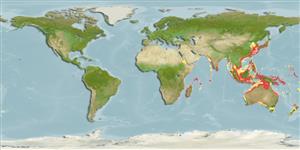Common names from other countries
Classification / Names / Names
ชื่อสามัญ | ชื่อพ้อง | Catalog of Fishes (gen., sp.) | ITIS | CoL | WoRMS
Environment: milieu / climate zone / depth range / distribution range
นิเวศวิทยา
; ระดับความลึก 0 - 100 m (Ref. 348). Tropical
Indo-West Pacific: from East Africa, to Melanesia; north to East China Sea and Japan, and south to Queensland and New Caledonia.
Length at first maturity / ขนาด / น้ำหนัก / Age
Maturity: Lm ? range ? - ? cm Max length : 5.0 cm SHL เพศผู้/กระเทย; (Ref. 348); common length : 4.0 cm SHL เพศผู้/กระเทย; (Ref. 348)
It is commonly collected for food in eastern Africa (Ref. 348).
Life cycle and mating behavior
วัยเจริญพันธุ์ | การสืบพันธุ์ | การวางไข่ | เซลสืบพันธ์ของเพศเมีย(ไข่) | ความดกของไข่ | ตัวอ่อน
Members of the class Bivalvia are mostly gonochoric, some are protandric hermaphrodites. Life cycle: Embryos develop into free-swimming trocophore larvae, succeeded by the bivalve veliger, resembling a miniature clam.
Poutiers, J.M. 1998. (Ref. 348)
IUCN Red List Status (Ref. 130435: Version 2024-1)
CITES status (Ref. 108899)
Not Evaluated
Not Evaluated
Threat to humans
Harmless
Human uses
| FishSource |
เครื่องมือ
ข้อมูลเพิ่มเติม
Age/Size
การเจริญเติบโต
Length-weight
Length-length
สัณฐานวิทยา
ตัวอ่อน
อุดมสมบรูณ์
แหล่งที่มาจากอินเตอร์เน็ต
Estimates based on models
Preferred temperature
(Ref.
115969): 23.1 - 29.1, mean 28 (based on 1996 cells).
Vulnerability
Low vulnerability (10 of 100).
